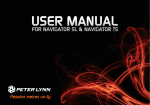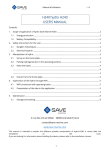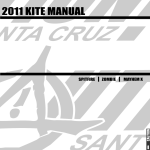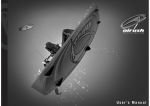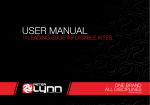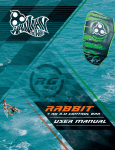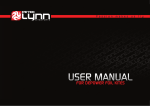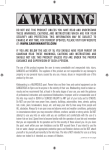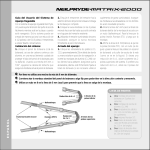Download Manual SF en OK
Transcript
User manual Semi Freddo Snow kite [Ram Air] This manual gives you detailed instructions on how to use your new Semi Freddo kite. We recommend you take your time to read the instructions. In case you have any further questions, please do not hesitate to contact us – we would be happy to provide more information. The JN team [email protected] 1.) JN Control Bar System Snow Product Overview On Semi Freddo kites 9 and 12, the wizard line should be attached to the upper wizard loops, while it should be attached to the lower loops nearer the bar on Semi Freddo 6. If the lower wizard loops are used on Semi Freddo 9 and 12, the kite will drop with significantly more power than it would with the recommended setup. 2.) Making Your Kite Ready To Fly The JN Semi Freddo comes with factory preset bridle lines. Your new CBS Snow will also be preset to the correct settings, so all you have to do is attach the 4 flying lines between the kite and the CBS. Assembly of CBS Snow and safety check 1. Attach all 4 flying lines to the leader lines on CBS Snow. 2. Check if all 4 lines are the same length, as this is a basic requirement for neutral kite trim. When checking, the adjuster must be open (maximum length) and the bar fully powered (touching the depower loop handle). In order to do this, thread all line ends on a string, which you then tie to a static object. Pull the bar and check if all lines are the same length. If they are, your CBS is ready for use. If the lines are NOT the same length, adjustments are necessary. For further details, see Fine Trimming Your Semi Freddo Kite 3. Attach all 4 flying lines to the kite. Attach flying lines to the kite lines according to colour code. Some Semi Freddo kites come as shown in picture A, while some come as in picture B. The slight difference does not affect kite performance. Picture A Picture B 3.) Fine Trimming Your Semi Freddo Kite If you are an experienced rider, you might try the following modifications to fine trim your Semi Freddo in order to suit your personal style. Get help from a professional if necessary! Reduce control line length => increase V leader line length Option 1: Shorten the control lines by moving the knot at the end of the control leader lines at the bar horn. Option 2: Fix the control leader lines with a knot instead of threading them in as shown above. Reduce V leader line length => increase control line length Fix the flying lines to the V leader lines with a knot instead of threading them in as shown above. 4.) Adjusting Your Kite During Sessions When all 4 flying lines are the same length we recommend the following CBS setups for the 4 wind situations described: Situation 1: Wind is strong enough for the kite to fly without effort Adjuster is fully open (maximum length), bar touches the stopper ball at the upper end of the depower line Kite should have ideal aspect ratio (neutral position): it should develop optimal pull and show no tendency to fall backwards in sufficiently strong wind In this neutral position, there should only be light tension on the front lines. The kite will react immediately to bar movements. It is very important riders find this basic setup through fine trimming, as this gives them maximum kite performance and power. Situation 2: Wind picks up strength and kite pull becomes too strong Shorten depower adjuster when wind strength increases. This will decrease the kite’s aspect ratio and, consequently, its pull. By pulling too hard at the adjuster loop, the kite will loose too much pull and will be more difficult to control for lack of tension on the control lines. Situation 3: Pull is too strong even if the kite is fully depowered (with adjuster at minimum length) Switch to a smaller kite size! Situation 4: Wind strength is at lowest point, kite barely flies See situation 1. Also try pulling the bar further down in order to power up the kite and increase tension on the front lines. With the bar too far down, the kite will fall backwards. Changing the neutral power position The neutral power position can be changed by moving the adjuster. As described in situation 1, ‘neutral position’ means the adjuster is fully open and the bar is at its highest point. Example: decreasing adjuster length by 5 cm means the bar’s neutral power position is now 5 cm below the upper stop. Expert tips for perfect kite control during sessions Tip 1: If your kite tips bend slightly inward when making drastic control moves with a fully depowered kite on a wind window edge, there are two options to choose from: 1. slightly pull the bar towards your body or 2. slightly increase ClamCleat adjuster length. Either one of these two options will keep the kite from the wind window edge and filled. Tip 2: Constantly trying to find the optimal aspect ratio by moving the bar up or down or slightly moving the adjuster gives your Semi Freddo maximum pull during sessions. If you feel the kite is flying fast but not developing sufficient pull, its aspect ratio might be too flat => pull the bar down slightly or move the adjuster. If you feel the kite is developing medium pull but heavily drifting leeward, you should try flattening its aspect ratio => push the bar up or decrease adjuster length. With a bit of exercise you will quickly develop a good sense for best pull and ideal fine trim. 5.) Safety Functions Please get familiar with the kite’s safety functions before use! Only knowing how the safety system works and what consequences activating the Quick Release system will have can you successfully use them in emergencies. We strongly recommend riders thoroughly practice safety system functions, use of the kite’s release system and reassembly of said systems first on land, then in safe light winds with enough leeward space. There are 2 options for hooking up the safety leash: 1. Hook safety leash to spinning leash Hooked-up safety leash This method is also safe for riders who want to practice unhooked manoeuvres and spinning jumps. If the rider looses the bar after a failed unhooked trick, the spinning leash QR between the depower line end and the adjuster will automatically be released the depower line will be interrupted the kite will fall backwards attached to the control lines and safety leash. This will also happen if the depower loop QR is released. The QR must be reassembled in order to relaunch the kite. If the kite is to be completely released, pull the red QR loop on the safety leash -> the safety leash will disconnect from the rider. ATTENTION: In strong winds, the kite might kite be blown away and injure bystanders! 2. Hook safety leash to wizard line A convenient option for riders who do not need to unhook the bar after spinning jumps (ideal for tours in open country). Unhook depower loop from harness hook and let go of bar the kite will fall backwards attached to the control lines and safety leash. Opening the spinning leash QR by pulling the red loop will have the same effect. If the kite is to be relaunched, get hold of the bar (keep in mind there is a left and a right side of the bar). In order for the kite not to develop too much pull, we recommend you only take hold of the ClamCleat and let the kite fly up to the zenith by putting tension on the centre lines. Once the kite is parked at the zenith, let go of the ClamCleat and control it with the bar (the spinning leash QR has to be reassembled before relaunching the kite). ATTENTION: In strong winds, the kite might fall backwards but still develop considerable pull. In emergencies, we recommend completely disconnecting the kite from the rider, except if there is any risk of injuring bystanders. Land the kite in time if wind strength increases too quickly! Expert tip: If you prefer the safety leash to be longer, just add a piece of strong line at the safety leash’s lower end. The safety leash is longer if attached to the front harness hook than to the back of the harness. 6. Handling And Assemby Of The 3 QRs On CBS Snow 1. Spinning Leash QR This QR is automatically released if the safety leash is attached to the spinning leash and the rider lets go of the bar. The spinning leash can also be manually released (e.g. if the safety leash is attached to the wizard line) by pulling the red loop. If this loop is too small for you, an additional, larger loop can be tied to it. Release the spinning leash QR by pulling the red loop Assembly of the spinning leash QR 1. Pull back Neoprene cover and push blue loop of lower part (1) through blue loop of upper part (2). 2. Push cotter pin into cotter pin sheath through blue loop. Fix red loop with Velcro. 3. Push Neoprene cover up to red loop over connecting piece. 4. Fully assembled spinning leash QR Expert tip: In most cases, if the bar is unhooked with the spinning leash after a number of spinning tricks in the same direction, the centre lines will still be twisted. This does not affect kite perfomance or rider safety. In order to untwist the centre lines, unhook the leash snap hook from the steel ring and turn the ring above the depower loop. Remember to put the leash snap hook back in place afterwards! 2. Depower loop QR The additional depower loop safety function is an emergency QR in case there is not enough time to quickly unhook from the depower loop. Pulling the red strap loop will release the depower loop QR. Assembly of the depower loop QR requires some experience and is best trained in advance. Release the QR by pulling the red loop Assembly of the depower loop 1. Pull open loop end through Neoprene cover from inside. 2. Widen grey loop with cotter pin, then remove cotter pin. 3. Push blue loop through grey loop. 4. From below, push cotter pin through blue loop over grey cord into black cotter pin sheath. 5. Fold loop Velcro seal and close tightly. 6. Pull Neoprene cover over QR and make sure Velcro seal is closed tight. After releasing the depower loop QR, hooking the harness hook onto the blue transverse connection on the depower loop (emergency hook) will allow you to safely return to the beach to reassemble the QR with the depower function still active. When hooked to the emergency hook, the spinning leash QR can be released in emergencies. 3. Safety Leash QR The safety leash QR as a second step allows you to completely disconnect from the kite, e.g. if a drifting kite is tangled up in yours and you loose control. As with the depower loop QR, reassembling this QR also requires some experience and should be trained in advance. Releasing the safety leash QR will completely disconnect the rider from their kite and is a measure for extreme emergencies only. Release safety leash QR Harness part (left) and snap hook part (right) Assembly of the Safety Leash QR: 1. Pull harness part through Neoprene tube with cotter pin sheath and seam facing up. 2. Fix Velcro to large Velcro patch under red loop. 3. Push harness part loop through snap hook loop. 4. Push cotter pin through harness loop over snap hook loop into black cotter pin sheath. 5. Tighten and seal Velcro. 6. Pull Neoprene cover towards red loop from both sides and fix well. 7.) Basics ATTENTION: These directions can not be regarded as substitute for a kiteboarding course! Theoretical and practical knowledge of kiteboarding required! CBS and flying lines are already attached to the kite as described in Par. 2 Preparations Unroll flying lines from the bar Unroll lines downwind from the bar Unroll kite at line ends with air inlets pointing leeward Weigh down rear edge of kite with sand, snow or sand bags Check if all bridle lines and steering system (yellow line with pulley) are free Starting the Kite Flying lines pointing upwind from the kite Kite lying on back, air inlets pointing upward Hook depower loop to harness hook and attach safety leash Push bar towards kite [into neutral position] In strong winds, put adjuster to minimum length for increased safety Take ClamCleat and pull until kite rises to zenith [ATTENTION: Do not touch QR as you might release it by accident] Bring kite into safe neutral position through optimal depower settings [see Adjusting Your Kite During Sessions]. Landing the Kite Safest method: Let a partner catch the kite at the edge of the wind window and bring it safely to the ground If your safety leash is hooked to the wizard line, you can unhook the depower loop from the harness hook and let go of the bar If your safety leash is attached to the spinning leash pull hard at the wizard line Kite will slowly fall backwards attached to the control lines ATTENTION: Kite pull depends on wind strength Further landing methods involve releasing the QR safety systems Relaunch If the kite is lying with its air inlets facing down, we recommend the folllowing steps: Grab wizard line and pull as far as necessary Kite will slowly rise backwards for 1–2 m and then make a 180° turn in the air. This operation might need assistance, such as pulling a control line or moving the bar Let the kite rise to the zenith by pulling the adjuster (NOT the QR!) as described above ATTENTION: Small kites will rise faster and turn around more quickly than larger ones Performing Jumps With the Kite This kite’s jumping technique is similar to that of a tube kite – pull the bar towards your body when taking off ATTENTION: You have to take off at higher speed than with a tube kite! Stowing Your Kite Away Lay kite on its back Arrange flying lines so they lead away from the kite over its trailing edge Roll lines onto bar, leaving the last 5 m. Secure against slipping off. Fold kite once, tip to tip All bridle lines should be covered by the folded kite, with only the flying lines extending out from the trailing edge Loosely roll up kite from tips to centre Roll rest of flying lines onto bar, leaving the last 50 cm, and secure Lay bar on kite horizontally and wrap kite around bar Secure with Velcro straps supplied with the kite Unroll kite at home and leave to dry 8. Safety Instructions Ideal conditions for your first Semi Freddo sessions: A large, free area with stable wind conditions, ideally with wind speeds around 7 –10 knots (= 13-18 km/h = 3.6-5.1 m/s). High trees upwind of you create turbulences and make for gusty winds with changing directions. Please keep a distance of several hundred metres. Keep approximately the same distance downwind – every single obstacle is potentially dangerous as the kite might get tangled up or drag you against it! Check your kite before every start Check the entire system of your JN Semi Freddo for possible defects before each start. Safety systems must work properly. If they are not replaced or repaired, damaged lines or canopies may lead to consequential damage or material faults in dangerous situations. Study the safety system functions in depth before your first session and practice the necessary moves in order to be prepared for emergency situations. Avoid at all costs - starting a faulty or damaged kite - flying your kite near power lines, railway lines, motorways, cable cars - steep slopes, as you might crash or get caught by uncontrollable wind currents - do not use your kite as a weapon or flying device - gusty winds with frequently changing direction make your first sessions more difficult and constitute significant danger.
























